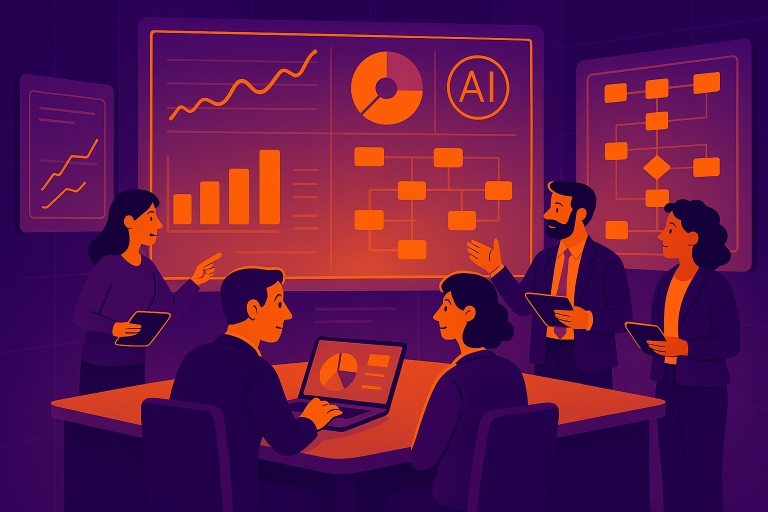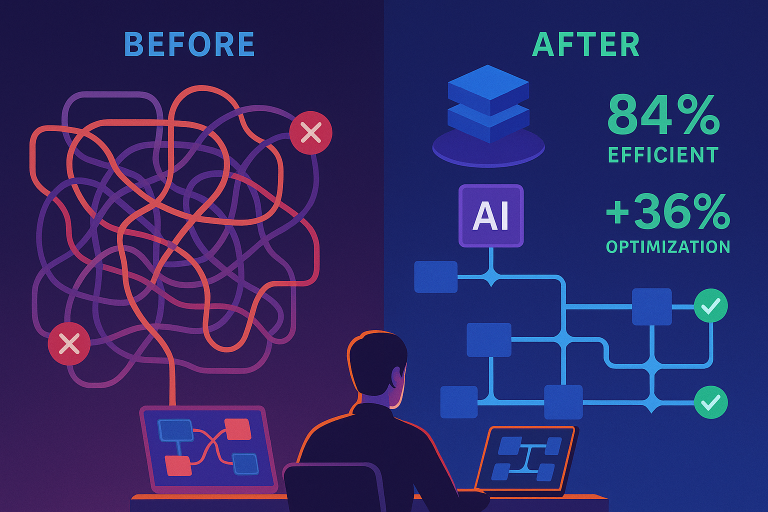Mastering Workflow Version Control with AI Process Management
In today’s fast-paced business environment, staying organized isn’t just good practice—it’s essential for survival. As processes become more complex and teams more distributed, keeping track of workflow changes, improvements, and iterations has become increasingly challenging. This is where workflow version control powered by artificial intelligence enters the picture, revolutionizing how organizations manage their business processes.

Understanding Workflow Version Control
Before diving into the transformative power of AI in this space, let’s establish a clear understanding of what workflow version control actually entails and why it matters for modern organizations.
What is Workflow Version Control?
Workflow version control is a systematic approach to tracking and managing changes to business processes, operational procedures, and workflow systems over time. Unlike traditional document version control—which primarily focuses on file revisions—workflow version control encompasses entire process ecosystems, including:
- Process definitions and maps that outline procedural steps
- Decision logic and business rules that guide operations
- Role assignments and responsibilities within each workflow
- Integration points with various systems and departments
- Triggers, conditions, and exceptions that influence process execution
This comprehensive approach ensures organizations maintain complete visibility into how their operational processes evolve over time, who made changes, why they were implemented, and how they impact overall business performance. The benefits of implementing a robust workflow version control system extend far beyond simple organization. Companies that effectively manage process versions experience:
- 56% faster onboarding of new team members
- 73% reduction in process-related errors
- 42% improvement in cross-functional collaboration
Why Process Versioning Matters
In today’s complex regulatory environment, process versioning isn’t just helpful—it’s often mandatory. Industries like healthcare, finance, and manufacturing face strict compliance requirements that necessitate meticulous documentation of operational procedures. Regulatory compliance becomes significantly easier when organizations can quickly demonstrate exactly how processes operated at any given point in time. During audits, the ability to produce historical process documentation with timestamps and authorization records can mean the difference between passing inspection and facing penalties. Beyond compliance, process versioning dramatically reduces operational errors. When team members can access the most current, approved process documentation, they’re less likely to follow outdated procedures or introduce unauthorized modifications. This consistency translates directly to higher quality outputs and greater customer satisfaction. Perhaps most importantly, historical process tracking provides invaluable insights for continuous improvement. By analyzing how processes have evolved and the impact of specific changes, organizations gain data-driven perspectives on what works, what doesn’t, and where future optimizations should focus.
The Role of AI in Workflow Version Control
Artificial intelligence fundamentally transforms workflow version control from a manual documentation exercise into a dynamic, intelligent system that actively contributes to organizational excellence.
AI-Driven Process Documentation
One of the most significant barriers to effective process management is the tedious nature of documentation. AI eliminates this obstacle through: Automated process mapping – AI systems can observe existing workflows through integration with business systems, automatically generating accurate process maps without human intervention. By analyzing system logs, user interactions, and digital footprints, AI constructs visual representations of how work actually flows through an organization. Natural language process descriptions – Modern AI can generate clear, readable process documentation in natural language that explains complex workflows in accessible terms. This bridges the gap between technical system operations and human understanding. Visual workflow generation – AI tools produce intuitive visual representations of processes, making it easier for stakeholders at all levels to comprehend operational flows. These visualizations automatically update as processes evolve, ensuring documentation always reflects reality.
| Traditional Documentation | AI-Driven Documentation |
|---|---|
| Manual process mapping | Automated observation and mapping |
| Text-heavy documentation | Visual process flows with natural language |
| Static documentation that quickly outdates | Dynamic documentation that updates automatically |
| Requires dedicated documentation time | Generated during regular workflow execution |
Intelligent Change Detection and Tracking
AI excels at monitoring processes and identifying deviations, enabling: Real-time process monitoring that continuously observes actual workflow execution against documented processes. When team members deviate from standard procedures—whether intentionally or accidentally—AI immediately detects these variations. Anomaly detection capabilities distinguish between positive process innovations and potentially problematic deviations. AI systems can learn to recognize when variations represent improvements versus when they indicate errors or compliance risks. Automated change documentation ensures that all process modifications are captured, logged, and appropriately cataloged without requiring manual recording. This creates a comprehensive, accurate history of how processes evolve over time.
Predictive Process Optimization
Perhaps the most exciting application of AI in workflow version control is its ability to not just document what is, but to suggest what could be: Process efficiency analysis automatically identifies areas where workflows can be streamlined or improved. By analyzing execution patterns, time investments, and outcomes, AI highlights opportunities for optimization. Bottleneck identification pinpoints exactly where processes slow down or encounter friction. This targeted insight allows organizations to focus improvement efforts precisely where they’ll have the greatest impact. Automated improvement suggestions provide actionable recommendations for process enhancement based on historical performance data, industry benchmarks, and pattern recognition. These AI-generated suggestions often identify optimization opportunities that human analysts might overlook.

Implementing Workflow Version Control Systems
Successfully implementing workflow version control requires careful planning, appropriate technology selection, and effective change management strategies.
Key Features of Effective Version Control Solutions
When evaluating workflow version control systems, organizations should prioritize solutions that offer: Branching and merging capabilities that allow teams to experiment with process variations in isolated environments before implementing changes in production workflows. This “sandbox” approach enables risk-free innovation and testing. Review and approval workflows with built-in governance to ensure proposed process changes receive appropriate scrutiny before implementation. These workflows should include notification systems, commenting capabilities, and electronic signature features. Integration with existing systems through robust APIs and pre-built connectors. The most effective version control solutions seamlessly integrate with business applications, ensuring comprehensive process visibility without disrupting established work practices.
Implementation Strategy and Best Practices
A successful implementation typically follows a phased approach:
- Discovery phase: Audit existing processes and documentation practices
- Pilot implementation: Begin with a single department or process area
- Evaluation and adjustment: Refine based on initial results
- Broader deployment: Expand to additional business areas
- Continuous improvement: Regular review and system optimization
Team training considerations are crucial for adoption. Even the best version control system will fail if users don’t understand how to use it effectively. Invest in comprehensive training that addresses both technical operation and the underlying principles of effective process management. Change management strategies should address the cultural shift required for successful implementation. Many organizations have deeply ingrained habits around process documentation (or lack thereof), and overcoming resistance requires clear communication about benefits, executive sponsorship, and visible early wins.
Common Implementation Challenges
Organizations should prepare for several common obstacles: Resistance to process documentation often emerges from team members who view documentation as bureaucratic overhead rather than valuable infrastructure. Overcoming this resistance requires demonstrating tangible benefits and making documentation as frictionless as possible. Integration with legacy systems can present technical challenges, particularly with older applications that lack modern API capabilities. Successful implementations typically require a combination of direct integration where possible and creative workarounds where necessary. Balancing automation with human oversight represents an ongoing challenge. While AI can dramatically reduce documentation burden, human judgment remains essential for evaluating process changes, ensuring compliance requirements are met, and validating AI-generated suggestions.
Business Impact and ROI
The business case for workflow version control becomes compelling when organizations measure concrete outcomes against implementation costs.
Measuring Efficiency Gains
Organizations implementing AI-powered workflow version control typically report significant improvements in several key areas: Time saved in documentation often represents the most immediate and visible benefit. Companies report documentation time reductions ranging from 60-85% after implementation, freeing knowledge workers to focus on higher-value activities. Error reduction metrics demonstrate how consistent, version-controlled processes directly impact quality. Organizations typically see a 35-70% decrease in process-related errors within the first year of implementation. Process cycle time improvements emerge as workflows become more efficient and bottlenecks are eliminated. The average organization achieves 28% faster process cycle times after implementing version control with AI optimization.
Compliance and Risk Management Benefits
Beyond efficiency, workflow version control delivers substantial risk management advantages: Audit trail capabilities provide comprehensive, tamper-resistant records of all process changes, including who made modifications, when changes occurred, and the rationale behind adjustments. This transparency dramatically simplifies compliance verification. Regulatory compliance advantages extend across industries, with particularly significant impact in highly regulated sectors. Financial services organizations report 64% less time spent preparing for regulatory audits after implementing comprehensive version control. Risk reduction outcomes translate to measurable business benefits, including reduced liability exposure, fewer compliance penalties, and lower insurance premiums in some industries.
Case Studies: Organizations Transforming Through Version Control
Across industries, organizations are achieving remarkable results: Healthcare Implementation: A regional hospital network implemented AI-driven workflow version control across their clinical operations, resulting in 43% faster protocol updates during the pandemic, 27% improvement in care guideline adherence, and significantly reduced documentation burden for clinical staff. Financial Services Transformation: A global investment firm utilized workflow version control to manage their complex compliance processes across multiple jurisdictions, achieving 71% faster responses to regulatory changes and complete elimination of fines for documentation deficiencies. Manufacturing Process Optimization: A precision parts manufacturer implemented version control for their quality assurance processes, resulting in 32% fewer defects, 18% faster production cycles, and documentation that enabled ISO certification with minimal additional effort.
Future Trends in AI-Powered Workflow Management
The evolution of AI capabilities promises even more powerful workflow version control systems in the near future.
Machine Learning Advancements
Next-generation systems will feature: Self-optimizing workflows that autonomously refine themselves based on performance data. Rather than simply suggesting improvements, these systems will implement and test optimizations automatically, continually enhancing process efficiency. Contextual process recommendations that adapt to specific situations and business conditions. These intelligent systems will recognize that the optimal workflow may vary depending on factors like time constraints, resource availability, or business priorities. Adaptive process modeling capabilities that automatically adjust to changing business environments. As organizations evolve, their workflow systems will evolve alongside them, eliminating the need for periodic major overhauls.
Integration with Emerging Technologies
The power of workflow version control will be amplified through integration with other emerging technologies: Blockchain for workflow verification will provide immutable, distributed records of process execution and changes. This will further enhance audit capabilities and enable secure process collaboration across organizational boundaries. IoT process triggers and monitoring will connect physical operations with digital workflow systems. As sensors and connected devices proliferate, workflow systems will respond automatically to real-world conditions and events. AR/VR for process visualization will transform how teams interact with process documentation. Immersive technologies will enable stakeholders to literally “walk through” complex workflows, dramatically improving understanding and training.
Conclusion: The Competitive Advantage of Intelligent Workflow Management
As organizations face increasing pressure to optimize operations, ensure compliance, and maximize efficiency, workflow version control powered by AI represents a critical competitive advantage. By transforming process documentation from a static record into a dynamic, intelligent system, organizations can simultaneously reduce administrative burden, improve operational excellence, and build resilient, adaptable business operations. The question is no longer whether organizations should implement workflow version control, but how quickly they can deploy these systems to avoid falling behind more agile competitors. Those who embrace AI-powered process management today are positioning themselves for success in an increasingly complex business landscape where operational excellence is not just an aspiration but a necessity. Are you ready to transform how your organization manages workflow knowledge?
Would you like to learn more about implementing AI-driven workflow version control in your organization? Contact our team for a personalized consultation or schedule a demo to see these capabilities in action.
